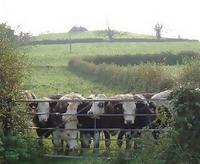Methane release
Methane is a greenhouse gas, and like CO2, it helps to trap the sun's warmth within the atmosphere. Weight for weight it warms the Earth 20 times more effectively than CO2, but there is much, much less of it.
The Earth's surface is full of stored methane.
Wetlands such as bogs, swamps, fens and marshes even shallow lakes are major sources of methane. Before the industrial revolution wetlands were the largest source of atmospheric methane - much greater than the  methane produced by cows. However, whilst wetlands in tropical regions will emit methane all year round, wetlands at high northern latitudes will only produce methane during the warmer months. When the ground is frozen, no methane can be given off.
methane produced by cows. However, whilst wetlands in tropical regions will emit methane all year round, wetlands at high northern latitudes will only produce methane during the warmer months. When the ground is frozen, no methane can be given off.
Melting permafrost releases methane
Concerns arise as global warming is leading to a  melting of the Arctic permafrost. Tundra previously thought to be permanently frozen is warming up and releasing methane like any other wetland. However, the methane released adds to the greenhouse effect, warming the Earth and melting the permafrost further. This in turn releases more methane, accelerating the heating effect with the possibility of things spiralling out of control.
melting of the Arctic permafrost. Tundra previously thought to be permanently frozen is warming up and releasing methane like any other wetland. However, the methane released adds to the greenhouse effect, warming the Earth and melting the permafrost further. This in turn releases more methane, accelerating the heating effect with the possibility of things spiralling out of control.
 Climategate: Ethics in sharing data
Climategate: Ethics in sharing data




 melting of the Arctic permafrost
melting of the Arctic permafrost Climategate: Ethics in sharing data
Climategate: Ethics in sharing data
What's your opinion?
Average rating




Not yet rated